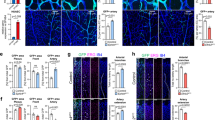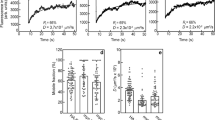Abstract
Blood vessels and nerves are complex, branched structures that share a high degree of anatomical similarity. Guidance of vessels and nerves has to be exquisitely regulated to ensure proper wiring of both systems. Several regulators of axon guidance have been identified and some of these are also expressed in endothelial cells; however, the extent to which their guidance functions are conserved in the vascular system is still incompletely understood. We show here that the repulsive netrin receptor UNC5B is expressed by endothelial tip cells of the vascular system. Disruption of the Unc5b gene in mice, or of Unc5b or netrin-1a in zebrafish, leads to aberrant extension of endothelial tip cell filopodia, excessive vessel branching and abnormal navigation. Netrin-1 causes endothelial filopodial retraction, but only when UNC5B is present. Thus, UNC5B functions as a repulsive netrin receptor in endothelial cells controlling morphogenesis of the vascular system.
This is a preview of subscription content, access via your institution
Access options
Subscribe to this journal
Receive 51 print issues and online access
$199.00 per year
only $3.90 per issue
Buy this article
- Purchase on Springer Link
- Instant access to full article PDF
Prices may be subject to local taxes which are calculated during checkout






Similar content being viewed by others
Change history
15 February 2023
Editor’s Note: Readers are alerted that the reliability of data presented in this manuscript is currently in question. Appropriate editorial action will be taken once this matter is resolved.
18 December 2023
An Editorial Expression of Concern to this paper has been published: https://doi.org/10.1038/s41586-023-06944-2
References
Carmeliet, P. Blood vessels and nerves: common signals, pathways and diseases. Nature Rev. Genet. 4, 710–720 (2003)
Gerhardt, H. et al. VEGF guides angiogenic sprouting utilizing endothelial tip cell filopodia. J. Cell Biol. 161, 1163–1177 (2003)
Ruhrberg, C. et al. Spatially restricted patterning cues provided by heparin-binding VEGF-A control blood vessel branching morphogenesis. Genes Dev. 16, 2684–2698 (2002)
Dickson, B. J. Molecular mechanisms of axon guidance. Science 298, 1959–1964 (2002)
Kawasaki, T. et al. A requirement for neuropilin-1 in embryonic vessel formation. Development 126, 4895–4902 (1999)
Moyon, D., Pardanaud, L., Yuan, L., Breant, C. & Eichmann, A. Plasticity of endothelial cells during arterial-venous differentiation in the avian embryo. Development 128, 3359–3370 (2001)
Yuan, L. et al. Abnormal lymphatic vessel development in neuropilin 2 mutant mice. Development 129, 4797–4806 (2002)
van der Zwaag, B. et al. PLEXIN-D1, a novel plexin family member, is expressed in vascular endothelium and the central nervous system during mouse embryogenesis. Dev. Dyn. 225, 336–343 (2002)
Gitler, A. D., Lu, M. M. & Epstein, J. A. PlexinD1 and semaphorin signaling are required in endothelial cells for cardiovascular development. Dev. Cell 7, 107–116 (2004)
Torres-Vazquez, J. et al. Semaphorin-plexin signaling guides patterning of the developing vasculature. Dev. Cell 7, 117–123 (2004)
Wang, H. U., Chen, Z. F. & Anderson, D. J. Molecular distinction and angiogenic interaction between embryonic arteries and veins revealed by ephrin-B2 and its receptor Eph-B4. Cell 93, 741–753 (1998)
Adams, R. H. et al. Roles of ephrinB ligands and EphB receptors in cardiovascular development: demarcation of arterial/venous domains, vascular morphogenesis, and sprouting angiogenesis. Genes Dev. 13, 295–306 (1999)
Gerety, S. S., Wang, H. U., Chen, Z. F. & Anderson, D. J. Symmetrical mutant phenotypes of the receptor EphB4 and its specific transmembrane ligand ephrin-B2 in cardiovascular development. Mol. Cell 4, 403–414 (1999)
Park, K. W. et al. Robo4 is a vascular-specific receptor that inhibits endothelial migration. Dev. Biol. 261, 251–267 (2003)
Kennedy, T. E., Serafini, T., de la Torre, J. R. & Tessier-Lavigne, M. Netrins are diffusible chemotropic factors for commissural axons in the embryonic spinal cord. Cell 78, 425–435 (1994)
Serafini, T. et al. The netrins define a family of axon outgrowth-promoting proteins homologous to C. elegans UNC-6. Cell 78, 409–424 (1994)
Cohen-Cory, S. The double life of netrin. Nature Neurosci. 5, 926–928 (2002)
Keino-Masu, K. et al. Deleted in Colorectal Cancer (DCC) encodes a netrin receptor. Cell 87, 175–185 (1996)
Hedgecock, E. M., Culotti, J. G. & Hall, D. H. The unc-5, unc-6, and unc-40 genes guide circumferential migrations of pioneer axons and mesodermal cells on the epidermis in C. elegans. Neuron 4, 61–85 (1990)
Leung-Hagesteijn, C. et al. UNC-5, a transmembrane protein with immunoglobulin and thrombospondin type 1 domains, guides cell and pioneer axon migrations in C. elegans. Cell 71, 289–299 (1992)
Hamelin, M., Zhou, Y., Su, M. W., Scott, I. M. & Culotti, J. G. Expression of the UNC-5 guidance receptor in the touch neurons of C. elegans steers their axons dorsally. Nature 364, 327–330 (1993)
Leonardo, E. D. et al. Vertebrate homologues of C. elegans UNC-5 are candidate netrin receptors. Nature 386, 833–838 (1997)
Ackerman, S. L. et al. The mouse rostral cerebellar malformation gene encodes an UNC-5-like protein. Nature 386, 838–842 (1997)
Hong, K. et al. A ligand-gated association between cytoplasmic domains of UNC5 and DCC family receptors converts netrin-induced growth cone attraction to repulsion. Cell 97, 927–941 (1999)
Fazeli, A. et al. Phenotype of mice lacking functional Deleted in colorectal cancer (Dcc) gene. Nature 386, 796–804 (1997)
Keleman, K. & Dickson, B. J. Short- and long-range repulsion by the Drosophila Unc5 netrin receptor. Neuron 32, 605–617 (2001)
Engelkamp, D. Cloning of three mouse Unc5 genes and their expression patterns at mid-gestation. Mech. Dev. 118, 191–197 (2002)
Przyborski, S. A., Knowles, B. B. & Ackerman, S. L. Embryonic phenotype of Unc5h3 mutant mice suggests chemorepulsion during the formation of the rostral cerebellar boundary. Development 125, 41–50 (1998)
Barallobre, M. J. et al. Aberrant development of hippocampal circuits and altered neural activity in netrin 1-deficient mice. Development 127, 4797–4810 (2000)
Deiner, M. S. et al. Netrin-1 and DCC mediate axon guidance locally at the optic disc: loss of function leads to optic nerve hypoplasia. Neuron 19, 575–589 (1997)
Jiang, Y., Liu, M. T. & Gershon, M. D. Netrins and DCC in the guidance of migrating neural crest-derived cells in the developing bowel and pancreas. Dev. Biol. 258, 364–384 (2003)
Barrett, C. & Guthrie, S. Expression patterns of the netrin receptor UNC5H1 among developing motor neurons in the embryonic rat hindbrain. Mech. Dev. 106, 163–166 (2001)
Liu, Y. et al. Novel role for netrins in regulating epithelial behavior during lung branching morphogenesis. Curr. Biol. 14, 897–905 (2004)
Leighton, P. A. et al. Defining brain wiring patterns and mechanisms through gene trapping in mice. Nature 410, 174–179 (2001)
Lawson, N. D. & Weinstein, B. M. Arteries and veins: making a difference with zebrafish. Nature Rev. Genet. 3, 674–682 (2002)
Lawson, N. D. & Weinstein, B. M. In vivo imaging of embryonic vascular development using transgenic zebrafish. Dev. Biol. 248, 307–318 (2002)
Lauderdale, J. D., Davis, N. M. & Kuwada, J. Y. Axon tracts correlate with netrin-1a expression in the zebrafish embryo. Mol. Cell. Neurosci. 9, 293–313 (1997)
Corset, V. et al. Netrin-1-mediated axon outgrowth and cAMP production requires interaction with adenosine A2b receptor. Nature 407, 747–750 (2000)
Shirasaki, R., Mirzayan, C., Tessier-Lavigne, M. & Murakami, F. Guidance of circumferentially growing axons by netrin-dependent and -independent floor plate chemotropism in the vertebrate brain. Neuron 17, 1079–1088 (1996)
Koch, M. et al. A novel member of the netrin family, beta-netrin, shares homology with the beta chain of laminin: identification, expression, and functional characterization. J. Cell Biol. 151, 221–234 (2000)
Llambi, F., Causeret, F., Bloch-Gallego, E. & Mehlen, P. Netrin-1 acts as a survival factor via its receptors UNC5H and DCC. EMBO J. 20, 2715–2722 (2001)
Tanikawa, C., Matsuda, K., Fukuda, S., Nakamura, Y. & Arakawa, H. p53RDL1 regulates p53-dependent apoptosis. Nature Cell Biol. 5, 216–223 (2003)
Carmeliet, P. et al. Targeted deficiency or cytosolic truncation of the VE-cadherin gene in mice impairs VEGF-mediated endothelial survival and angiogenesis. Cell 98, 147–157 (1999)
Yin, Y., Sanes, J. R. & Miner, J. H. Identification and expression of mouse netrin-4. Mech. Dev. 96, 115–119 (2000)
Wang, H., Copeland, N. G., Gilbert, D. J., Jenkins, N. A. & Tessier-Lavigne, M. Netrin-3, a mouse homolog of human NTN2L, is highly expressed in sensory ganglia and shows differential binding to netrin receptors. J. Neurosci. 19, 4938–4947 (1999)
Westerfield, M. The Zebrafish Book. A Guide for the Laboratory Use of Zebrafish (Danio Rerio) (Univ. Oregon Press, Eugene, 1994)
Stalmans, I. et al. VEGF: a modifier of the del22q11 (DiGeorge) syndrome? Nature Med. 9, 173–182 (2003)
Sugiyama, D. et al. Erythropoiesis from acetyl LDL incorporating endothelial cells at the preliver stage. Blood 101, 4733–4738 (2003)
Acknowledgements
We thank members of U36 for critical discussions; E. Etienne, A. Réaux, C. Esguerra and S. Maity for their expertise; C. Betsholtz for the Pdgfrb probe; H. Gerhardt for sharing unpublished data; and H. Rayburn, C. Jolicoeur, J. Zhong, S. Terclavers, A. Claes, A. Vanhuffelen and S. Wyns for technical support. This work was supported by grants from Inserm (Avenir), Fondation Schlumberger pour l'Education et la Recherche (FSER), Ministère de l'Education et de la Recherche (ACI Biologie du Développement), Association pour la Recherche contre le Cancer (ARC) to A.E., a European Union grant to A.E. and P.C., and grants to M.T.-L. from the NIMH and the NHLBI. F.l.N. was supported by the Royal Dutch Academy of Science (KNAW) and Avenir; X.L. by the Damon Runyon Cancer Research Foundation; and M.T.-L. by the Howard Hughes Medical Institute.
Author information
Authors and Affiliations
Corresponding authors
Ethics declarations
Competing interests
M.T.-L. is an inventor of patents covering members of the mammalian UNC5 and netrin families. He is a member of the scientific advisory board and a shareholder of Renovis Inc., and is employed by and a shareholder of Genentech Inc. Both companies have a commercial interest in members of these families.
Supplementary information
Supplementary Figure 1
Unc5b expression in arterial endothelial cells in the mouse retina. Double-labelings of retina wholemounts with isolectinB4, lacZ, Unc5b and pdgfr-β in situ hybridizations. (PPT 6999 kb)
Supplementary Figure 2
Generation of Unc5b mutant mice. Representation of gene inactivation strategy and evidence for absence of Unc5b transcripts in homozygous mutant mouse embryos. (PPT 1596 kb)
Supplementary Figure 3
Specificity of zebrafish morpholino knockdowns (a) and Northern blot analysis of Unc5b expression in primary human endothelial cells (b). (PPT 955 kb)
Supplementary Figure 4
Aortic ring assays. Overview of aortic ring cultures in controls, in the presence of netrin-1/UNC5B-Fc and in the presence of netrin-1, as well as statistical analysis of endothelial cell movement. (PPT 171 kb)
Supplementary Movie 1
Control endothelial tip cell. Random filopodial movement. (MOV 3447 kb)
Supplementary Movie 2
Endothelial tip cells faced with a gradient of pre-clustered Netrin-1/UNC5B-Fc. Random filopodial movement. (MOV 1745 kb)
Supplementary Movie 3
Endothelial tip cells faced with a gradient of Netrin-1, note filopodial retraction and backward movement of the cells. (MOV 3369 kb)
Rights and permissions
About this article
Cite this article
Lu, X., le Noble, F., Yuan, L. et al. The netrin receptor UNC5B mediates guidance events controlling morphogenesis of the vascular system. Nature 432, 179–186 (2004). https://doi.org/10.1038/nature03080
Received:
Accepted:
Published:
Issue Date:
DOI: https://doi.org/10.1038/nature03080
This article is cited by
-
Brain-derived endothelial cells are neuroprotective in a chronic cerebral hypoperfusion mouse model
Communications Biology (2024)
-
Hypofucosylation of Unc5b regulated by Fut8 enhances macrophage emigration and prevents atherosclerosis
Cell & Bioscience (2023)
-
What the Stanford president’s resignation can teach lab leaders
Nature (2023)
-
Urinary and circulatory netrin-1 as biomarker in diabetes and its related complications: a systematic review and meta-analysis
Endocrine (2023)
-
A Comparative Investigation of Axon-Blood Vessel Growth Interaction in the Regenerating Sciatic and Optic Nerves in Adult Mice
Molecular Neurobiology (2023)
Comments
By submitting a comment you agree to abide by our Terms and Community Guidelines. If you find something abusive or that does not comply with our terms or guidelines please flag it as inappropriate.



